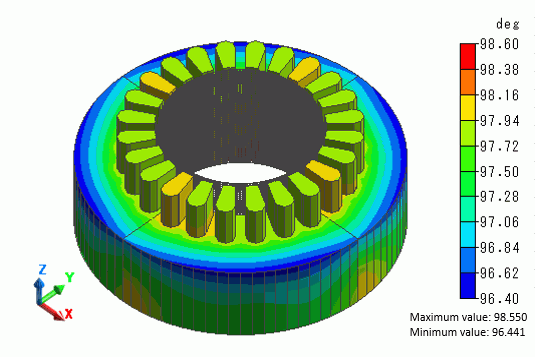
CAE Software【Femtet】Murata Software Co., Ltd.

Example1 Thermal Analysis of IPM Motor
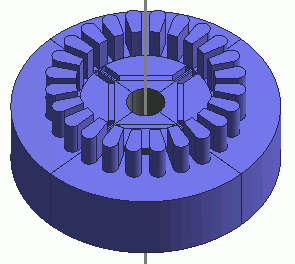
General
-
Temperature and torque characteristics of IPM motor (Interior Permanent Magnet Motor) are analyzed when the electricity is applied.
The model is a permanent magnet synchronous motor with magnets built in a rotor. -
The analysis is coupled with the external circuit.
-
The homogenizing method is applied to simulate the layer structure of the electromagnetic plates of steel for the core.
-
Fast stabilizer is employed to make the magnetic field reach the steady state in short calculation time.
-
Temperature, torque and magnetic flux density are solved.
-
Unless specified in the list below, the default conditions will be applied.
Analysis Conditions
|
Item |
Setting |
|
Solver |
Magnetic Field Analysis [Luvens] Thermal Analysis [Watt] |
|
Analysis Type |
Magnetic field analysis: Transient Analysis Thermal analysis: Steady-State Analysis |
|
Unit |
mm |
|
Options |
Select External Circuit Coupling. Select Rotating machinery.
[Conversion] Model Thickness: 30×10^-3[m] Select Partial Model. Number of Divisions of the Whole Model: 4 Circuit Configuration Number of Series: 1 Circuit Configuration Number of parallels: 1 Select Convert the result to the whole model and output it. |
The Rotating Machinery tab is set as follows.
|
Tab |
Setting Item |
Setting |
|
Rotating Machinery |
Rotational Movement |
Select Constant Velocity. Number of Rotations: 1800[r/min] Rotor’s Initial Rotation Position: 0[deg] |
|
Number of Slide Mesh Divisions |
Circumferential Division Angle: 1.0[deg] Rotation per Step: 1[mesh] Number of Slide Mesh Layers: 3 |
External circuit is as follows.
60[Hz] three-phase AC voltage is applied.
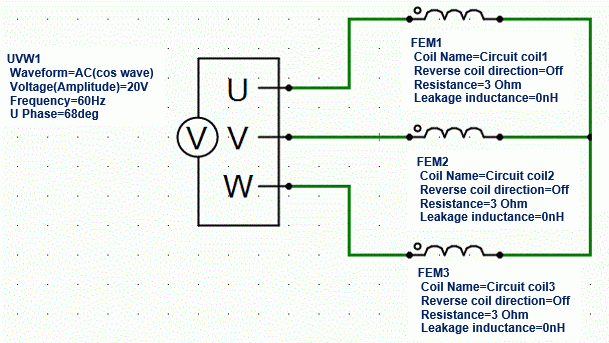
Set the Mesh Tab as follows.
|
Tab |
Setting Item |
Setting |
|
Mesh |
Meshing Setup |
Automatically set the general mesh size: Deselect General mesh size: 4[mm] |
|
Ambient Air Creation |
Select Create ambient air automatically. Ambient Air Scale: 1.2 |
The Transient Analysis tab is set up as follows.
With the settings as below, number of steps is 450, circumferential division angle is 1.0[deg], and rotation per step is 1[mesh], the rotation up to 450 degrees (=450*1.0*1) is analyzed.
The steps are set until the magnetic field reaches the steady state.
|
Tab |
Setting Item |
Setting |
|||||
|
Transient Analysis |
Time step |
Automatic |
|||||
|
Table |
|
Fast stabilizer is set up as follows to make the magnetic field reach the steady state in short calculation time.
|
Tab |
Setting Item |
Setting |
|
Fast Stabilizer |
Correction Method |
Simplified Three-Phase AC TP-EEC Method |
|
Coil Name on the External Circuit |
U Coil: Circuit_Coil1 V Coil: Circuit_Coil2 W Coil: Circuit_Coil3 |
Graphical Objects
A rotor core and magnet are placed in the center. A stator and coils are placed around them.
This is a 3D model analysis. By utilizing the symmetry of the model, it is made to be a quarter model.
Half period rotation boundary (symmetry) is set.
“Ambient Air Creation” is selected.
Adiabatic boundary condition is set on the shaft and the gap between stator and rotor.
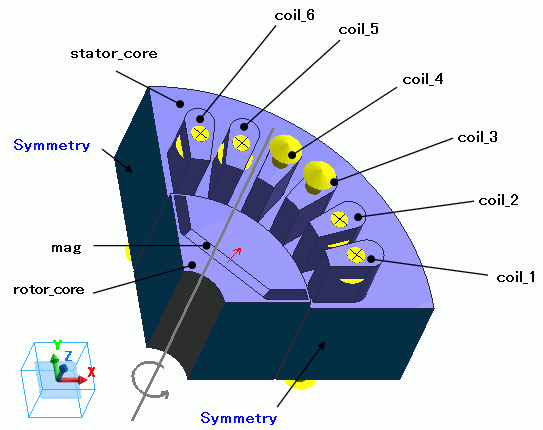
Body Attributes and Materials
|
Body Number/Type |
Body Attribute Name |
Material Name |
|
28/Solid |
coil_1 |
Cu |
|
34/Solid |
coil_2 |
Cu |
|
35/Solid |
coil_3 |
Cu |
|
36/Solid |
coil_4 |
Cu |
|
37/Solid |
coil_5 |
Cu |
|
38/Solid |
coil_6 |
Cu |
|
55/Solid |
mag |
mag |
|
45/Solid |
stator_core |
core |
|
47/Solid |
rotor_core |
core |
The body attribute is set up as follows.
For the core, the homogenizing method is selected to simulate the layered steel plates.
|
Body Attribute Name |
Tab |
Setting |
|
coil_1 |
Current |
Waveform: External Circuit Coupling Coil Name on the Circuit: Circuit_Coil1 Turns: 35[Turns] Direction: Specify Inflow/Outflow Faces |
|
Stator/Rotor/Air |
Stator |
|
|
coil_2 |
Current |
Waveform: External Circuit Coupling Coil Name on the Circuit: Circuit_Coil1 Turns: 35[Turns] Direction: Specify Inflow/Outflow Faces |
|
Stator/Rotor/Air |
Stator |
|
|
coil_3 |
Current |
Waveform: External Circuit Coupling Coil Name on the Circuit: Circuit_Coil2 Turns: 35[Turns] Direction: Specify Inflow/Outflow Faces |
|
Stator/Rotor/Air |
Stator |
|
|
coil_4 |
Current |
Waveform: External Circuit Coupling Coil Name on the Circuit: Circuit_Coil2 Turns: 35[Turns] Direction: Specify Inflow/Outflow Faces |
|
Stator/Rotor/Air |
Stator |
|
|
coil_l5 |
Current |
Waveform: External Circuit Coupling Coil Name on the Circuit: Circuit_Coil3 Turns: 35[Turns] Direction: Specify Inflow/Outflow Faces |
|
Stator/Rotor/Air |
Stator |
|
|
coil_6 |
Current |
Waveform: External Circuit Coupling Coil Name on the Circuit: Circuit_Coil3 Turns: 35[Turns] Direction: Specify Inflow/Outflow Faces |
|
Stator/Rotor/Air |
Stator |
|
|
mag |
Direction |
Vector: X=1, Y=1, Z=0 |
|
Stator/Rotor/Air |
Rotor |
|
|
rotor_core |
Layer |
Select Take layer into account Space: 97[%] Layer Direction Vector: X=0, Y=0, Z=1 |
|
Stator/Rotor/Air |
Rotor |
|
|
stator_core |
Layer |
Select Take layer into account Space: 97[%] Layer Direction Vector: X=0, Y=0, Z=1 |
|
Stator/Rotor/Air |
Stator |
The material properties are set as follows.
|
Material Name |
Tab |
Properties |
|||||||||||||||||||||
|
Cu |
Conductivity |
Conductivity Type: Conductor Conductivity: 5.977×10^7[S/m] |
|||||||||||||||||||||
|
Thermal Conductivity |
Thermal Conductivity: 398[W/m/deg] |
||||||||||||||||||||||
|
mag |
Relative permeability |
Material Type: Permanent Magnet |
|||||||||||||||||||||
|
Magnet |
Magnetization Characteristic Type: Linear Magnetization Strength: 1.25 Relative Permeability: 1.05 |
||||||||||||||||||||||
|
Thermal Conductivity |
Thermal Conductivity: 1[W/m/deg] |
||||||||||||||||||||||
|
core |
Electric Conductivity |
Conductivity Type: Conductor Conductivity: 1.7 x10^6[S/m] |
|||||||||||||||||||||
|
Permeability |
Magnetization Characteristic Type: Select B-H curve B-H Curve Table
|
||||||||||||||||||||||
|
Thermal Conductivity |
Thermal Conductivity: 10[W/m/deg] |
Boundary Conditions
“Natural convection (automatic calculation)” is set on the outer boundary condition (surrounding the motor in the case of the thermal analysis).
Half period symmetric boundary is set.
Adiabatic boundary condition is set on the shaft and the gap between stator and rotor.
|
Boundary Condition Name/Topology |
Tab |
Boundary Condition Type |
Setting |
|
Outer Boundary Condition * |
Thermal |
Heat Transfer/Ambient Radiation |
Natural convection (automatic calculation) Room temperature: 25[deg] |
|
shaft |
Thermal |
Adiabatic |
|
|
rotor |
Thermal |
Adiabatic |
|
|
stator |
Thermal |
Adiabatic |
|
|
Symmetry |
Symmetry/Continuity |
Periodic |
Rotation Period (Half Period) |
To set Outer Boundary Condition, go to the [Model] tab

and click [Outer Boundary Condition] ![]() .
.
Results
The distribution of the magnetic flux density at 450 calculation steps.
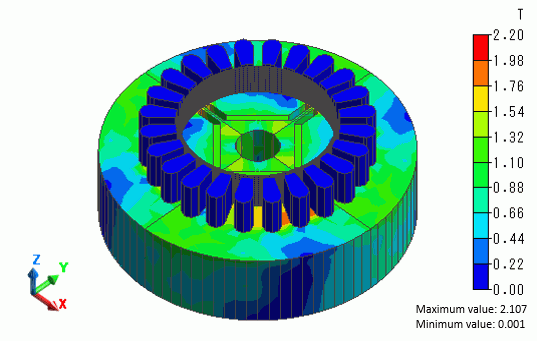
The diagram below shows time-torque characteristics.
Transient state becomes stable at around 20[ms].
About 0.5[N*m] of torque is obtained.
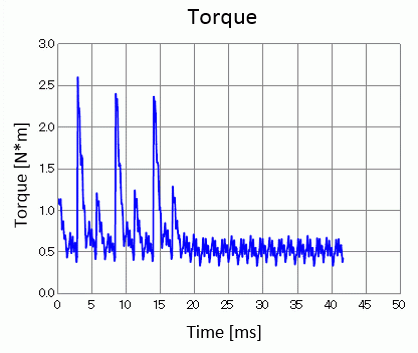
The diagram below shows the temperature distribution of the stator.
In the steady state, it is around 100[deg].
